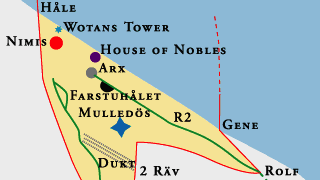Muhammad Cartoonist Fathers Micronation

The cartoonist who escaped death in Copenhagen in a revenge attack for his Muhammad drawings is no stranger to controversy. To vent his frustration with the Swedish nanny state, Lars Vilks fathered a micronation — recognized by none, but visited by thousands every year.
Kullaberg is a nature reserve in southwest Sweden. With its rocky coastline dropping away into the Kattegat, it would have made a perfect location for Vikings, the History Channel series about the half-legendary ninth-century Norse ruler and raider Ragnar Lothbrook.
Today, the region is the homeland of another Scandinavian troublemaker: Vilks, the Swedish cartoonist who escaped assassination in an attack in Copenhagen in early 2015. Vilks drew the ire of radical Muslims in 2007 when the Swedish press published cartoons by him of the prophet Muhammad as a dog [1].

But Vilks, who has lived under police protection since he became the target of death threats, is more than a controversial cartoonist. He is also an installation artist, one whose unauthorized sculptures in Kullaberg have put him at loggerheads with the Swedish state. So much so that in 1996 he proclaimed the independence of the square kilometer of forest surrounding his sculpture park.
Of course, the Royal Republic (sic) of Ladonia [2] itself is yet another of Vilks’ provocative works. Where other micronations often take the pageantry of nationhood very seriously indeed, Ladonia is a dadaist play on the pomp of state symbols.

Mr. Vilks on the border between Sweden and Ladonia. N is for Nimis.
For starters, the country has both a king and a president (hence its title), and it has not one but two national anthems — one of which consists of the sound a stone makes when dropped in the sea. And it has declared war on both Sweden and San Marino, the world’s oldest micronation [3].
As other micronationalists have noticed, wrapping your anti-government protest in a state flag of your own design [4] is a sure-fire way to get picked up by the press. Sometimes with unintended consequences. When word got out that anyone could apply for Ladonian citizenship, and for free, Vilks received over 4,000 requests for political asylum from Pakistan.
Ladonia today has about 15,000 citizens, all of which reside outside the country. As does the Queen: Carolyn I lives in Chicago, and her daughter, the Crown Princess Greta of Ladonia, is a student at Miami University in Ohio. The president of Ladonia at present seems to be a human; in an interview with Belgian newspaper Het Belang van Limburg in 2012, Vilks maintained that the presidency was held by a pair of shoes.

Apart from the president, the government consists of a variety of ministers, often overseeing an interesting mix of departments. There is a minister of Time and Llamas, and one of Brazilian Romantic Literature and Washing Lines. There is also a minister of Offence, and one of Offense. The day-to-day running of Ladonia falls to the Secretary of State, Vilks, whose face features on Ladonia’s money [5].
Ladonia may be a virtual state, but it has also become a very real tourist destination. Each year, about 40,000 visitors make the trek to the isolated sculpture park, braving a half-hour forest walk and a steep descent over rocks to see Nimis, Arx and — if they are lucky enough to find it — Omphalos.
Vilks started work on Nimis in 1980. Assembled from 75 tons of driftwood, the installation rises up to 18 meters above the beach, fanning out into the rocks and trees of the hinterland. Hammered together with approximately 170,000 nails and in constant need of repair, it may be the single largest construction ever single-handedly built.

Nimis in all its chaotic glory.
But the Swedish state was not impressed, and went to court to have the work removed from the Kullaberg Nature Reserve. After two decades of legal proceedings, involving the transfer abroad of ownership of Nimis [6], Vilks was vindicated (or the Swedish state just gave up, we’re not sure).
As if to cement his win, Vilks constructed another work, in rock and concrete, next to Nimis. As he sees it, Arx is not (just) a sculpture; it is (also) a book. He even carved an ISBN number in its base.

Size does matter: Omphalos, the government-approved version.
A third work, Omphalos, was destroyed by the Swedish state. A crane vessel removed the stone pillar. But Vilks’ revenge was twofold. The original Omphalos was acquired by the Moderna Museet in Stockholm. And Vilks received official permission to install a replacement — but no more than 8 centimeters high. Civil servants have visited Ladonia to verify its correct height. The micro-pillar is the only sculpture in Ladonia placed there with permission of the Swedish government, showing that either the Swedish government has a good idea of its own ridiculousness — or that it hasn’t. Either way, it’s an excellent addition to Ladonia, the absurd virtual nation born out of frustration with the genuine article.
Maps of Ladonia reproduced with kind permission of the Government of Ladonia. Many thanks to Roel Damiaans and Sven Dillen at Het Belang van Limburg. Mr. Dillen’s images reproduced by kind permission of Mediahuis.
Strange Maps #702
Got a strange map? Let me know at [email protected].
[1] Not as just any type of dog, but as a rondellhund: a roundabout dog. Typically made of wood, this form of street art started popping up on Swedish roundabouts in 2006. Usually produced by anonymous local artists, the rondellhund phenomenon was interpreted as, among other things, an indictment of state-funded art.
[2] The country was named after Ladon, the dragon of Greek mythology who guarded the tree with the golden apples in the Garden of the Hesperides.
[3] And the world’s oldest nation per se. San Marino, southwest of Rimini on Italy’s Adriatic coast, was founded in 301 AD by Saint Marinus.
[4] Ladonia’s flag is the ‘Glorious Green’, a green Scandinavian cross on a background of exactly the same green. The cross is only discernible by its stitching.
[5] On both the 100 and 500 billion örtug bank note. For reference: 1 örtug is about 1 euro.
[6] The statue was acquired in 1984 by the German artist Joseph Beuys, and after his death was transferred to the artist couple Christo and Jeanne-Claude.





